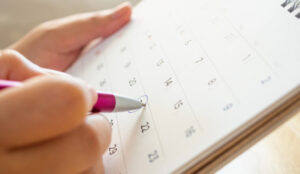 Sandra likes having a way to track all of the information related to her menstrual cycle. This helps her to understand the rhythms of her body and predict her most fertile days. She is a visual person, and artistic, and enjoys being creative. An Ovulation Calendar is fun for her.
Sandra likes having a way to track all of the information related to her menstrual cycle. This helps her to understand the rhythms of her body and predict her most fertile days. She is a visual person, and artistic, and enjoys being creative. An Ovulation Calendar is fun for her.
The best way is to just take a regular calendar with empty squares for each day of the month. Dedicate it to tracking the data related to your menstrual cycle. It is fun and very helpful to see it all in one place. And you can add lots of details.
How Can an Ovulation Calendar Help?
- It is a visual tool on which to document your menstrual cycles
- Having this information will help you to determine your most fertile days
- Knowing your most fertile days will help you get pregnant
What information goes on the Ovulation Calendar?
- Start with the first day of your menstrual cycle
- Calculate when you may ovulate and mark it
- Note your most fertile days, the 5 days before and the day of ovulation
- Add other signs of ovulation and fertility specific to this cycle
- Get creative with colors, symbols and pictures
- Make it fun!
Mark the first day of this menstrual cycle. The first day of your menstrual cycle is the day you begin bleeding. The last day is the day before you begin bleeding again the next time.
Mark expected range of ovulation. You usually ovulate 14 days before your next period. You can mark the likely days you may ovulate by taking the longest and shortest cycles you have had and subtract 14. So if you have a 25 day cycle, you may ovulate on day 11. If you have a 32 day cycle, you may ovulate on day 19.
Mark your expected most fertile days. Your most fertile days are the 5 days before and the day of ovulation.
Add other signs as they occur. This is where you really fine-tune your knowledge of your own fertility. Note when your cervical mucus becomes fertile mucus. Note when your cervix becomes higher, softer and more open. Note when you have a ferning pattern when testing your saliva. Note when you have a positive LH surge. And finally, note when your basal body temperature rises and your window of fertility has passed.
And a few more things. Mark down when you make love. Note if you stayed up late, did not get enough sleep, if you were stressed or sick. You are creating knowledge about your own body.
Have fun. Get creative. Use colored pens or pencils. Mark the fertile days in a particular color. Create your own private symbol for making love. Make notes about things that have meaning for you.
How is an ovulation calendar different than a fertility chart? A fertility chart is a graph and best for keeping track of your basal body temperatures. There is usually space to note a few other things – the position of your cervix, your cervical mucus, etc.
I highly recommend that you do both as you learn to understand your fertility. The more details you learn about yourself, the better you can predict your most fertile days, and increase your chances of getting pregnant. It will also give you very important information about the health of your fertility. Sometimes just knowing when you are supposed to be fertile is not enough, as you may have already found out.
Save your ovulation calendars, as they will be an invaluable store of knowledge to you and those you enlist as allies to help you on your fertility journey.
To Your Vibrant Health!
Veronica Tilden, DO

